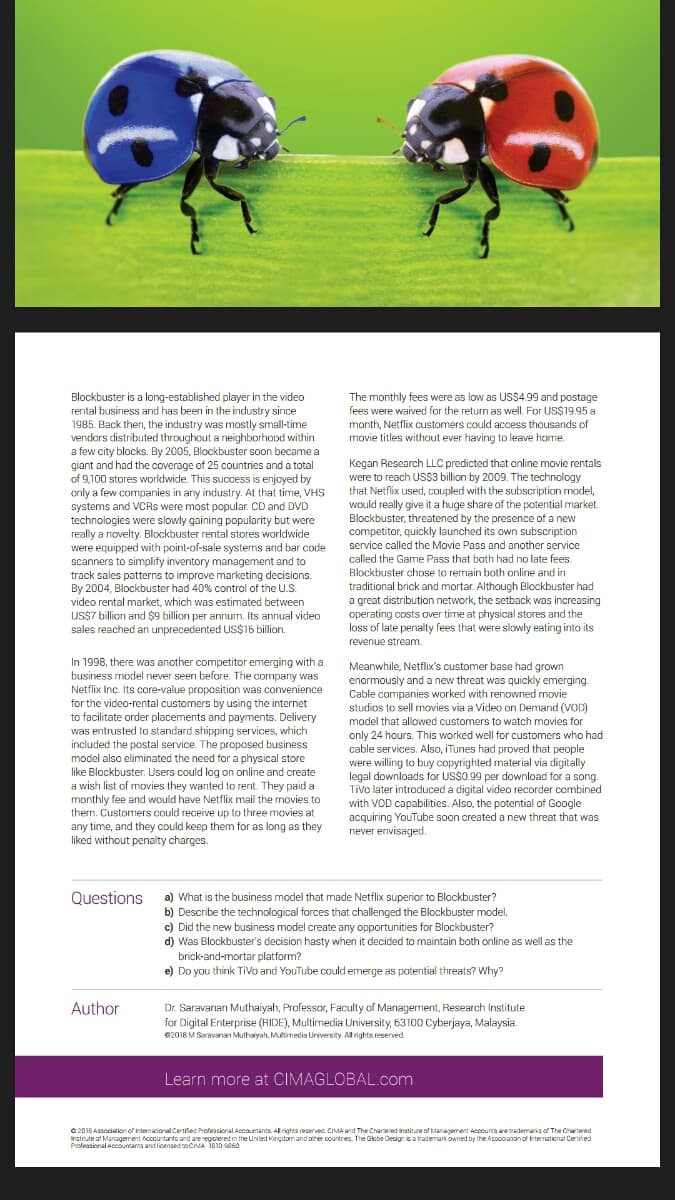a) What is the business model that made Netflix superior to Blockbuster? b) Describe the technological forces that challenged the Blockbuster model. c) Did the new business model create any opportunities for Blockbuster?
a) What is the business model that made Netflix superior to Blockbuster? b) Describe the technological forces that challenged the Blockbuster model. c) Did the new business model create any opportunities for Blockbuster?
Practical Management Science
6th Edition
ISBN:9781337406659
Author:WINSTON, Wayne L.
Publisher:WINSTON, Wayne L.
Chapter2: Introduction To Spreadsheet Modeling
Section: Chapter Questions
Problem 20P: Julie James is opening a lemonade stand. She believes the fixed cost per week of running the stand...
Related questions
Question
100%
Kindly find attached the image and answer

Transcribed Image Text:The monthly fees were as low as US$4.99 and postage
fees were waived for the return as well. For US$19.95 a
Blockbuster is a long-established player in the video
rental business and has been in the industry since
1985. Back then, the industry was mostly small-time
vendors distributed throughout a neighborhood within
a few city blocks. By 2005, Blockbuster soon became a
giant and had the coverage of 25 countries and a total
of 9,100 stores worldwide. This success is enjoyed by
only a few companies in any industry. At that time, VHS
systems and VCRS were most popular. CD and DVD
month, Netflix customers could access thousands of
movie titles without ever having to leave home.
Kegan Research LLC predicted that online movie rentals
were to reach US$3 billion by 2009. The technology
that Netflix used, coupled with the subscription model,
would really give it a huge share of the potential market.
Blockbuster, threatened by the presence of a new
competitor, quickly launched its own subscription
technologies were slowly gaining popularity but were
really a novelty. Blockbuster rental stores worldwide
were equipped with point-of-sale systems and bar code
scanners to simplify inventory management and to
track sales patterns to improve marketing decisions.
By 2004, Blockbuster had 40% control of the U.S.
video rental market, which was estimated between
US$7 billion and $9 billion per annum. Its annual video
sales reached an unprecedented US$16 billion.
service called the Movie Pass and another service
called the Game Pass that both had no late fees.
Blockbuster chose to remain both online and in
traditional brick and mortar. Although Blockbuster had
a great distribution network, the setback was increasing
operating costs over time at physical stores and the
loss of late penalty fees that were slowly eating into its
revenue stream.
In 1998, there was another competitor emerging with a
business model never seen before. The company was
Netflix Inc. Its core-value proposition was convenience
for the video-rental customers by using the internet
to facilitate order placements and payments. Delivery
was entrusted to standard shipping services, which
included the postal service. The proposed business
model also eliminated the need for a physical store
like Blockbuster. Users could log on online and create
a wish list of movies they wanted to rent. They paid a
monthly fee and would have Netflix mail the movies to
them. Customers could receive up to three movies at
any time, and they could keep them for as long as they
liked without penalty charges.
Meanwhile, Netflix's customer base had grown
enormously and a new threat was quickly emerging.
Cable companies worked with renowned movie
studios to sell movies via a Video on Demand (VOD)
model that allowed customers to watch movies for
only 24 hours. This worked well for customers who had
cable services. Also, iTunes had proved that people
were willing to buy copyrighted material via digitally
legal downloads for US$0.99 per download for a song.
Tivo later introduced a digital video recorder combined
with VOD capabilities. Also, the potential of Google
acquiring YouTube soon created a new threat that was
never envisaged.
gon
Questions
a) What is the business model that made Netflix superior to Blockbuster?
b) Describe the technological forces that challenged the Blockbuster model.
c) Did the new business model create any opportunities for Blockbuster?
d) Was Blockbuster's decision hasty when it decided to maintain both online as well as the
brick-and-mortar platform?
e) Do you think Tivo and YouTube could emerge as potential threats? Why?
Author
Dr. Saravanan Muthaiyah, Professor, Faculty of Management, Research Institute
for Digital Enterprise (RIDE), Multimedia University, 63100 Cyberjaya, Malaysia.
02018 M Seravanan Muthaiyah, Multimedia University. Alrights reserved
Learn more at CIMAGLOBAL.com
G 2018 Associarion of internarional Certiied Profeasional Accoutants. Al righra reserved. CIMA and The Chanered institure of Management Acccunta are ademerks of The Chartered
Instrute of Management Acccuntarts and are regctered in the United Kingdomand other countries. The Globe Designisa trademark owned by the Asscoationof International Certified
Professional Acoountama and licansed to CIMA 1810-860
Expert Solution
This question has been solved!
Explore an expertly crafted, step-by-step solution for a thorough understanding of key concepts.
Step by step
Solved in 3 steps

Knowledge Booster
Learn more about
Need a deep-dive on the concept behind this application? Look no further. Learn more about this topic, operations-management and related others by exploring similar questions and additional content below.Recommended textbooks for you

Practical Management Science
Operations Management
ISBN:
9781337406659
Author:
WINSTON, Wayne L.
Publisher:
Cengage,

Operations Management
Operations Management
ISBN:
9781259667473
Author:
William J Stevenson
Publisher:
McGraw-Hill Education

Operations and Supply Chain Management (Mcgraw-hi…
Operations Management
ISBN:
9781259666100
Author:
F. Robert Jacobs, Richard B Chase
Publisher:
McGraw-Hill Education

Practical Management Science
Operations Management
ISBN:
9781337406659
Author:
WINSTON, Wayne L.
Publisher:
Cengage,

Operations Management
Operations Management
ISBN:
9781259667473
Author:
William J Stevenson
Publisher:
McGraw-Hill Education

Operations and Supply Chain Management (Mcgraw-hi…
Operations Management
ISBN:
9781259666100
Author:
F. Robert Jacobs, Richard B Chase
Publisher:
McGraw-Hill Education


Purchasing and Supply Chain Management
Operations Management
ISBN:
9781285869681
Author:
Robert M. Monczka, Robert B. Handfield, Larry C. Giunipero, James L. Patterson
Publisher:
Cengage Learning

Production and Operations Analysis, Seventh Editi…
Operations Management
ISBN:
9781478623069
Author:
Steven Nahmias, Tava Lennon Olsen
Publisher:
Waveland Press, Inc.